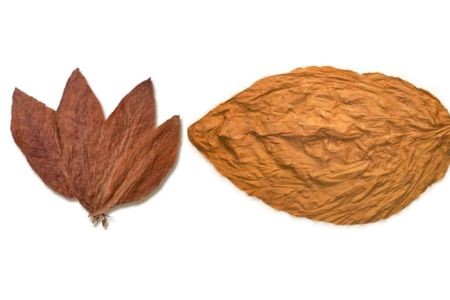Shisha tobacco has emerged and spread widely due to its new manufacturing process techniques. These include the introduction of new flavors and ensuring high-quality products are produced for its customers or consumers.
1. Shisha Tobacco Leaf Selection

Leave selection is the first process of manufacturing techniques. In this process quality tobacco leaves are selected based on different characteristics like flavor, texture, and aroma. The shisha tobacco leaf will determine the strength of the hookah tobacco.
This is because different leaves have different characteristics and are mixed to achieve the desired characteristics.
Dark tobacco leaves have high nicotine content hence giving high-quality shisha tobacco.
2. Cleaning Process in Shisha Tobacco
After selecting the best quality shisha tobacco leaves that are not damaged by pests, the cleaning process is necessary.
Cleaning the leaves with water and it can be done manually or mechanically. The technique should get rid of any possible contaminants such as pests, dust, etc.

3. Moisturizing and Flavoring Technique in Shisha Tobacco Manufacturing
For proper hydration, you will add moisture to your shisha tobacco for subsequent processes. Remember, it is this moisture that makes shisha tobacco heat tolerant.
Usually, miniaturization will also ensure better smoke production when smoking.
Additionally, you should add more flavors to shisha tobacco. Good flavoring techniques help to execute and excite your taste buds and change the entire smoking experience.
Ingredients used in flavoring shisha tobacco include:

· Tobacco
Made from tobacco leaves from a variety like large amounts of nicotine, carbon monoxide, tar, and other toxins. Tobacco is usually cultivated, moist, and mild.
· Molasses/Honey
This helps to give it a sticky texture and improves the taste and experience of smoking.
· Vegetable Glycerin
It helps in retaining moisture and also contributes to producing the thickness of shisha tobacco when it’s heated.
· Flavoring
The availability of a variety of flavors attracts more tobacco consumers as they explore different flavors like fruit mint, chocolate, and caramels.
Flavoring Techniques
The techniques mainly focus on:
- Select the flavors you would like to use and set them aside.
- Shred and mix them into smaller pieces to avoid lumps.
- Add equal portions of each flavor you want to blend.
- Mix thoroughly and let it blend together
Layering Technique of Shisha Tobacco
The layering of shisha tobacco helps to create different flavor combinations to come out at different times. Each layer usually has a unique taste experience when the flavors combine.
Steps in Shisha Tobacco Layering
- Select the flavors you want to layer and set them aside.
- Grind the tobacco leaves into fine particulars and mix them thoroughly.
- Focus on the ratio of your flavors to find the perfect base. Ensure you use the packing technique depending on the type of bowl you are using for layering. Distribute the tobacco evenly.
- Add the first layer of tobacco at the top base flavor add another layer with a different flavor and again add a little tobacco and distribute it evenly.
- To put more layers, keep on repeating the processes again and again until you reach the layer you want.
- Put the charcoal with heat and keep on monitoring it to maintain the temperature we need for the shisha tobacco. This helps to avoid overheating of shisha tobacco.
- Draw a smoke through the layers as this allows the flavors to mix and blend creating the perfect taste and aroma for its uses or consumers.
- The intensity of each flavor can be felt by taking a deep breath while smoking it.
Shisha Tobacco Sectioning
Shisha tobacco sectioning techniques entail placing different flavors side by side in a bowl as they blend.
Steps in Shisha Tobacco Sectioning
- Choose the flavors you want to section and select two to three flavors that you think are compatible with each other to ensure the flavor you want to mix is enough for sectioning.
- Place the flavors you want to use and ensure you understand the strength of every component of the bowl before partitioning them inside. Use should consider the right technique or the appropriate technique based on the kind of bowl type you’re using.
- Separate each section with a heat-resistant aluminum foil.
- Fill every section with tobacco and ensure it is distributed evenly among the sections.
- Place a charcoal with heat and distribute it evenly as you keep on monitoring it.
- Allow the flavors to mix by drawing a smoke through each section.
4. Aging or Fermenting in Shisha Tobacco Techniques

Fermenting is the process by which sugar are transformed into different products through chemical reaction and ammonia is released from the plants to make it more sociable.
Usually, fermenting helps to produce the best quality shisha tobacco with the best aroma and taste. Aged Shisha offers a better experience to its consumers.
Fermenting or Aging is left for several days depending on the preferences of the consumers or manufacturers.
Methods of Fermenting Shisha
Stacking Method
This type of fermenting is mainly used by large-scale growers. Stacks of tobacco are wrapped in burlap and allowed to sweat until it reaches around 40°. The stack breaks down to remove tar, ammonia, and nicotine
Kiln Method of Fermenting.
This method is mainly used by small-scale growers. Klin is a small insulated container that contains an artificial heat source that helps to stimulate fermentation.
Benefits of fermenting or Aging Shisha Tobacco
- It helps to eliminate odor and degrading harmful substances.
- Fermenting helps to produce a specific flavor of your choosing.
- Helps to fight bacteria by giving them minimal chance to survive.
- It helps to produce quality shisha tobacco.
5. Techniques used in Shisha Tobacco Quality Control Process
Six Sigma
Mostly used by companies waiting to control the defects and variations in their processes. Six Sigma helps to remove the defects in the processes of Shisha tobacco which helps to improve quality and customer satisfaction.
Six Sigma quality control uses different variety of tools and statistics not only to find the problem but also help to fix it and continuously monitor it.
Lean
Lean is a quality control technique used to identify and eliminate flab. Flabs are dead weight carried through the process of production adding any value or weight. This process helps to ensure customer or consumers does not pay for weight.
Lean quality control does not require one to increase capital costs.
Inspection
This is where an inspector selects a random product tests it and then ranks. It can be ranked in the chart. This chart determines if the product meets the quality standards.
Benefits of Quality Control Process in Shisha Tobacco Productions
- Increase customer satisfaction
- Improve production method
- Increase Goodwill
- Ensures effective use of resources
- Boost sales
- Helps improve effectiveness
- It ensures that product quality and standards are maintained
Conclusion
Shisha tobacco involves different production techniques before it reaches its customers. These techniques involve shisha tobacco leaf selection, cleaning method, moisturizing method, flavoring method, Aging or fermenting, and quality control process as mentioned above.
More Resources:
Shisha Tobacco Manufacturing – Source: JOCHAMP
Hookah – Source: WIKIPEDIA
Shisha Tobacco Leaf – Source: JOCHAMP
Shisha Tobacco Flavor – Source: JOCHAMP


